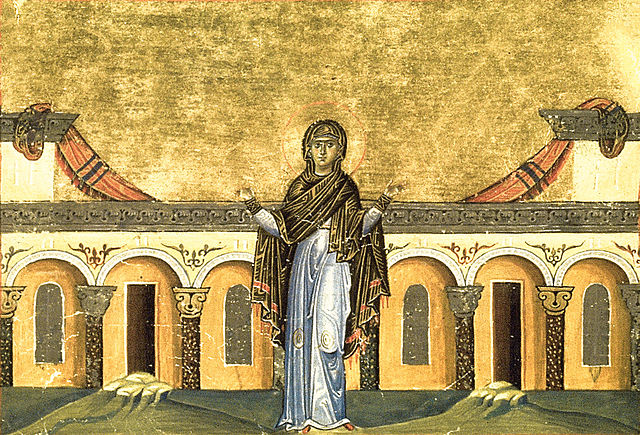Paula of Rome was an ancient Roman Christian saint and early Desert Mother. A member of one of the richest senatorial families which claimed descent from Agamemnon, Paula was the daughter of Blesilla and Rogatus, from the great clan of the Furii Camilli. At the age of 16, Paula was married to the nobleman Toxotius, with whom she had four daughters, Blaesilla, Paulina, Eustochium, and Rufina. She also had a boy, also named Toxotius. As a disciple of Jerome, she is considered the first nun in the history of Christianity.
Saint Paula (or An Abbess). Painting of Juan de Valdés Leal (1622–1690) in Musée de Tessé [fr], Le Mans, France.
Saint Jerome with Saint Paula and Saint Eustochium (painting of Francisco de Zurbarán at National Gallery of Art in Washington)
Desert Mothers is a neologism, coined in feminist theology as an analogy to Desert Fathers, for the ammas or female Christian ascetics living in the desert of Egypt, Palestine, and Syria in the 4th and 5th centuries AD. They typically lived in the monastic communities that began forming during that time, though sometimes they lived as hermits. Monastic communities acted collectively with limited outside relations with lay people. Some ascetics chose to venture into isolated locations to restrict relations with others, deepen spiritual connection, and other ascetic purposes. Other women from that era who influenced the early ascetic or monastic tradition while living outside the desert are also described as Desert Mothers.
Desert Mothers Saint Paula and her daughter Eustochium with their spiritual advisor Saint Jerome—painting by Francisco de Zurbarán
Melania the Younger, from the Menologion of Basil II
Syncletica of Alexandria from the Menologion of Basil II

![Saint Paula (or An Abbess). Painting of Juan de Valdés Leal (1622–1690) in Musée de Tessé [fr], Le Mans, France.](https://upload.wikimedia.org/wikipedia/commons/thumb/d/d5/Juan_de_Valdes_Leal_-_Santa_Paula_de_Roma.jpg/363px-Juan_de_Valdes_Leal_-_Santa_Paula_de_Roma.jpg)


